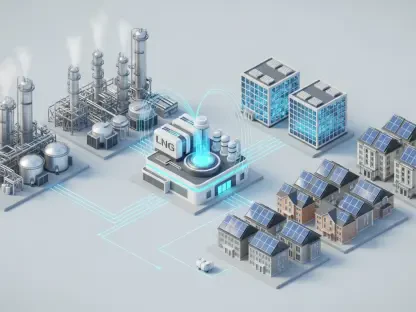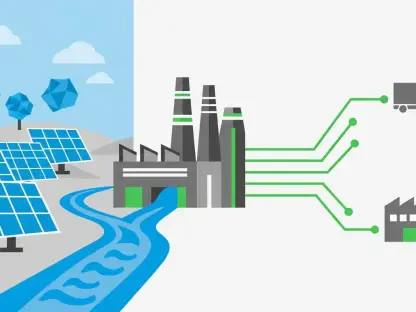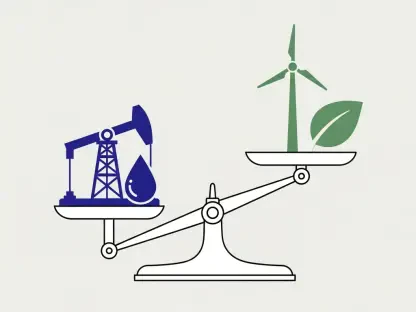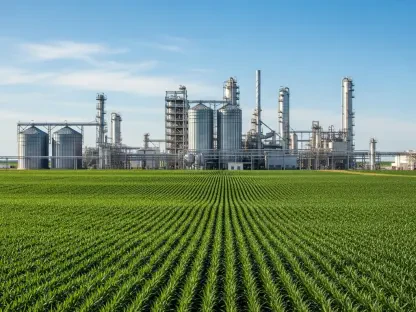In the heart of Spain’s countryside, a quiet revolution is unfolding that could redefine the nation’s future, as rural regions emerge as the backbone of a sustainable energy landscape and account for an impressive 84% of the country’s renewable energy production. These areas are no longer just agricultural strongholds but critical players in the fight against climate change and the drive for economic revitalization. A pivotal conference held in Toledo, titled “Rural Environment: Energy Transition and Economic Integration,” hosted by the Association of Electric Power Companies (aelēc) and the Regional Confederation of Businessmen of Castilla-La Mancha (CECAM), brought this transformation into sharp focus. Insights from a comprehensive report by Monitor Deloitte, presented at the event, underscored how rural Spain is poised to lead not only in clean energy but also in job creation and regional cohesion. This convergence of environmental goals and economic opportunities paints a promising picture for a nation seeking balance between progress and sustainability.
Driving Sustainability from the Countryside
Rural Spain stands as a powerhouse in the nation’s renewable energy sector, contributing the vast majority of clean power that fuels homes and industries alike. Industry leaders, government officials, and business representatives at the Toledo conference, including Marina Serrano of aelēc and Alipio García Rodríguez, Director General of Energy Transition for Castilla-La Mancha, highlighted the strategic importance of these regions. With expansive landscapes and climates ideal for solar and wind projects, rural areas are uniquely positioned to help Spain meet ambitious sustainability targets. Beyond mere energy production, this shift represents a chance to redefine rural identity, transforming these regions into hubs of innovation where environmental progress aligns with tangible community benefits, setting a precedent for other nations to follow.
The momentum in rural Spain is not just about numbers but about a broader vision for a greener future. The significant contribution of 84% to national renewable energy output showcases how these areas are indispensable to the country’s climate goals. Discussions at the conference emphasized that this energy transition offers a dual advantage: reducing carbon footprints while stimulating local economies. Voices from various sectors agreed that leveraging rural potential requires strategic planning and investment, ensuring that the benefits of clean energy extend beyond urban centers. This perspective reinforces the idea that rural regions are not peripheral but central to national development, providing a foundation for long-term environmental and economic stability across Spain.
Regional Strengths Amid Population Struggles
Certain regions, such as Castilla-La Mancha, Castilla y León, and Aragón, are emerging as leaders in renewable energy development, showcasing remarkable potential for growth. Castilla-La Mancha, for instance, generates over a quarter of its electricity from solar photovoltaic sources and is exploring opportunities in biomass and energy storage. The Monitor Deloitte report presented at the Toledo conference highlighted these areas as critical to scaling up clean energy production. However, the challenge of depopulation looms large, with provinces like Cuenca and Albacete experiencing population densities well below the national average. Addressing this demographic decline through energy-driven initiatives could breathe new life into these communities, offering a pathway to sustainable progress.
While regional strengths in renewable energy are evident, the socioeconomic hurdles cannot be ignored, particularly the risk of rural areas becoming ghost towns. The low population densities in many provinces, as noted in the Monitor Deloitte findings, create a paradox where vast land availability for energy projects contrasts with shrinking local workforces. Energy initiatives are seen as a potential solution, capable of attracting industries and creating jobs that could stem the tide of depopulation. Conference speakers stressed that targeted policies and incentives are essential to ensure that these regions not only produce energy but also retain and grow their populations. This dual focus on energy expansion and demographic recovery could transform struggling areas into thriving centers of opportunity.
Building the Foundation with Infrastructure
A recurring theme at the Toledo conference was the critical need for robust infrastructure, especially in electricity grids, to support rural Spain’s role in the energy transition. Marina Serrano of aelēc pointed out that without modernized and expanded grids, the full potential of renewable sources remains untapped, hindering both energy distribution and industrial growth. Business leaders like Mario Fernández of CECAM advocated for Castilla-La Mancha to become a prime destination for investment by prioritizing energy infrastructure. This consensus among stakeholders underscores that a strong grid network is the backbone of rural development, enabling these regions to integrate clean energy seamlessly into the national system.
Infrastructure investment goes beyond technical upgrades; it is a catalyst for broader economic vitality in rural areas. The discussions in Toledo revealed that outdated grids pose a significant barrier to attracting businesses that could revitalize local economies. Enhancing these networks would not only facilitate the integration of solar and wind power but also position rural regions as competitive industrial hubs. The call for action was clear: government and private sector collaboration must prioritize funding and innovation in grid technology to ensure that rural Spain can sustain its energy contributions. This focus on infrastructure represents a foundational step toward unlocking the full spectrum of benefits that the energy transition promises for these communities.
Merging Agriculture with Clean Energy
An innovative approach gaining attention in rural Spain is the fusion of agriculture and renewable energy through agrivoltaic projects, which integrate solar power generation with farming activities. According to the Monitor Deloitte report, such initiatives can enhance water retention by up to 60% and boost pollination, offering environmental benefits alongside energy production. In provinces like Cuenca and Guadalajara, where agriculture plays a significant economic role, agrivoltaics also diversifies farmers’ income streams. Conference participants from both agricultural and energy sectors highlighted the practical advantages of this synergy, positioning it as a model for sustainable rural development that respects traditional livelihoods.
The intersection of energy and agriculture presents a unique opportunity to strengthen rural economies while advancing clean energy goals. Unlike urban areas, rural Spain relies heavily on farming, with agriculture contributing a much higher share to local GDP compared to the national average. Agrivoltaic systems, as discussed in Toledo, can protect crops from extreme weather while generating renewable power, creating a win-win scenario. This approach not only addresses environmental challenges but also ensures that rural communities remain economically viable. By blending modern energy solutions with age-old agricultural practices, Spain can pave the way for a balanced model of rural progress that other regions might emulate.
Fostering Collaboration for Lasting Impact
The energy transition in rural Spain hinges on collaboration among diverse stakeholders, a key insight from the Toledo conference where voices from government, energy, and agriculture converged. Alipio García Rodríguez emphasized the importance of citizen dialogue to build social acceptance for renewable projects, ensuring that development aligns with community needs. This multi-stakeholder approach recognizes that technical advancements alone are insufficient; projects must also be socially sustainable to succeed. The event served as a platform for exchanging ideas on how to balance rapid energy expansion with local concerns, highlighting the value of inclusive planning.
Beyond dialogue, the need for ongoing engagement with rural communities emerged as a priority to sustain the energy transition. Conference discussions revealed that social pushback can derail even the most promising renewable initiatives if local perspectives are overlooked. Building trust through transparent communication and involving residents in decision-making processes are seen as vital steps to overcome resistance. This collaborative spirit extends to partnerships between public and private entities, which can pool resources and expertise to address complex challenges. By prioritizing community involvement, rural Spain can ensure that its contributions to national energy goals are both impactful and enduring.
Paving the Way for a Sustainable Legacy
Reflecting on the insights shared at the Toledo conference, it became evident that rural Spain has carved out a significant role in the nation’s energy landscape, contributing 84% of renewable power and setting a benchmark for sustainable development. The discussions, supported by the Monitor Deloitte report, illuminated how regions like Castilla-La Mancha have led the charge with solar innovations while grappling with demographic challenges. Infrastructure gaps have been identified as critical barriers, yet the promise of agrivoltaics offers a glimpse of harmony between traditional farming and modern energy needs. As stakeholders have collaborated to address social acceptance, a foundation has been laid for future progress. Moving forward, the focus should shift to actionable strategies—securing funding for grid modernization, scaling agrivoltaic pilots, and deepening community partnerships—to ensure that rural areas continue to drive Spain’s journey toward a greener, more equitable economy.









